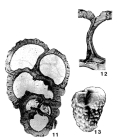Foraminifera taxon details
Victoriella Chapman & Crespin, 1930 †
722290 (urn:lsid:marinespecies.org:taxname:722290)
accepted
Genus
Carpenteria proteiformis var. plecte Chapman, 1921 † accepted as Victoriella conoidea (Rutten, 1914) † (type by monotypy)
marine, brackish, fresh, terrestrial
fossil only
feminine
Chapman, F.; Crespin, I. (1930). Rare foraminifera from deep borings in the Victorian Tertiaries Victoriella gen. nov., Cycloclypeus communis Martin and Lepidocyclina borneensis Provale. <em>Proceedings of the Royal Society of Victoria, new ser.</em> 42: 110-115., available online at https://www.biodiversitylibrary.org/page/54507128
page(s): p. 111 [details]
page(s): p. 111 [details]
Hayward, B.W.; Le Coze, F.; Vachard, D.; Gross, O. (2021). World Foraminifera Database. Victoriella Chapman & Crespin, 1930 †. Accessed at: http://www.marinespecies.org/foraminifera/aphia.php?p=taxdetails&id=722290 on 2024-04-23
Date
action
by
original description
Chapman, F.; Crespin, I. (1930). Rare foraminifera from deep borings in the Victorian Tertiaries Victoriella gen. nov., Cycloclypeus communis Martin and Lepidocyclina borneensis Provale. <em>Proceedings of the Royal Society of Victoria, new ser.</em> 42: 110-115., available online at https://www.biodiversitylibrary.org/page/54507128
page(s): p. 111 [details]
basis of record Loeblich, A. R.; Tappan, H. (1987). Foraminiferal Genera and their Classification. Van Nostrand Reinhold Company, New York. 970pp., available online at https://books.google.pt/books?id=n_BqCQAAQBAJ [details] Available for editors [request]
[request]
page(s): p. 111 [details]
basis of record Loeblich, A. R.; Tappan, H. (1987). Foraminiferal Genera and their Classification. Van Nostrand Reinhold Company, New York. 970pp., available online at https://books.google.pt/books?id=n_BqCQAAQBAJ [details] Available for editors
From editor or global species database
Diagnosis Test conical, free in the juvenile stage, forming a low trochospiral coil, later becoming temporarily or permanently attached by the apex, with a sharp reverse in coiling direction and then high spired around an axial hollow, chambers inflated, three to four per whorl, sutures depressed but early ones obscured by secondary deposition of lamellae; wall calcareous, optically radial, thick and coarsely perforate, except for the imperforate region around the aperture, may have pillarlike thickenings in the wall that displace the perforations and appear at the surface as rounded to elliptical bosses, septa trilamellar; aperture umbilical, bordered by a thick lip. U. Eocene to M. Oligocene; Australia; New Guinea; New Zealand; Europe. (Loeblich & Tappan, 1987, Foraminiferal Genera and Their Classification) [details]
